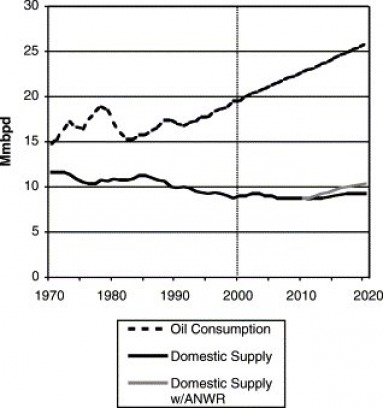Should We Drill in ANWR?
Is Drilling in ANWR a Viable Solution? The Controversy.
Fig 1. World Hubbert Peak (Fairey, 2009)

It is clear then, that dependence on oil is a matter of grave concern. One purported solution to this problem is drilling for oil in domestic areas with known reserves. Of course this solution ignores the problem of global warming caused by the burning of fossil fuels (as many, but not all, proponents for this solution don't believe global warming to be caused by burning fossil fuels, which is another matter of grave concern).
One such area cited as a candidate for drilling is the 1002 section of The Arctic National Wildlife Reserve (ANWR), one of the world's largest (and last) wildlife habitats, which houses a vast number of animal and plant species (see our section on the Ecosystem of ANWR for a more detailed discussion of this). This area is currently protected against development by the Alaska National Interest Lands Conservation Act of 1980, but in light of the area's proven reserves of oil and recent spikes in oil prices, the debate over whether to drill there has been reignited in recent years. While drilling in ANWR is not likely to help wean us off oil, the two main arguments made by proponents for drilling are that it could lower the price of oil and help reduce US dependence on foreign oil (again, lowering carbon emissions is decidedly not a goal of this proposed solution). Although, some have argued that taxes from oil revenues could be put to good use in protecting the environment, thereby creating a net positive outcome for the ecosystem (Snyder 2007, 937-39) (to see why this doubtful, please see our section's on environmental impacts of drilling in ANWR, as damages to the ecosystem take hundreds of years to reverse and many species could be lost in the meantime). As it turns out, all of the outcomes purported by the supporters of drilling, are highly unlikely.
One such area cited as a candidate for drilling is the 1002 section of The Arctic National Wildlife Reserve (ANWR), one of the world's largest (and last) wildlife habitats, which houses a vast number of animal and plant species (see our section on the Ecosystem of ANWR for a more detailed discussion of this). This area is currently protected against development by the Alaska National Interest Lands Conservation Act of 1980, but in light of the area's proven reserves of oil and recent spikes in oil prices, the debate over whether to drill there has been reignited in recent years. While drilling in ANWR is not likely to help wean us off oil, the two main arguments made by proponents for drilling are that it could lower the price of oil and help reduce US dependence on foreign oil (again, lowering carbon emissions is decidedly not a goal of this proposed solution). Although, some have argued that taxes from oil revenues could be put to good use in protecting the environment, thereby creating a net positive outcome for the ecosystem (Snyder 2007, 937-39) (to see why this doubtful, please see our section's on environmental impacts of drilling in ANWR, as damages to the ecosystem take hundreds of years to reverse and many species could be lost in the meantime). As it turns out, all of the outcomes purported by the supporters of drilling, are highly unlikely.
Fig. 2. US oil consumption and production including ANWR. From Energy Information Adminsistration. Graphic from Cleveland and Kaufmann (2003)

First of all, how much oil is there? Our best estimation is that there is approximately 7.8 BBO (Billion Barrels of Oil), with a 5% chance that there are 11 BBO, in the 1002 area. This is according to the US Geological Survey released in 2001. This sounds like a lot of oil. Unfortunately, it only ends up being about what the US consumed in 2005, give or take a few months (Kotchen and Burger, 2007). Assuming we decided to give drilling the green light today, it wouldn't begin production until 2018 and wouldn't reach it's peak until 2025, producing just under 1 Mb/d (Million Barrels per Day) and at that peak would likely account for around 3% of US oil consumption (Kotchen and Burger, 2007).
As to drilling in ANWR changing the price of oil or reducing our dependence, Kotchen and Burger (2007, 4723) had this to say, “the quantity of oil in ANWR, 7.06 BBO, is merely 0.55% of the proven reserves worldwide (EIA, 2006b) Analysts also recognize that even if ANWR's supplies were large enough to affect world prices, OPEC would countermand the increase in production and thereby negate any price effects (EIA, 2004; Gelb, 2005).” Cleveland an Kaufmann (2003, 487) similarly point out that, “In the unlikely case that OPEC acts with no foresight” to drilling in ANWR, the amount of production ANWR put out would only, “reduce the OPEC's share of the world oil market by 2-3 percent. Such a change would be virtually undetectable given the large fluctuations in crude oil prices.”
It has, in fact, been pointed out by many that drilling in ANWR would be insuffient in lowering the price or in significantly altering our dependence on foreign oil and furthermore that it would not significantly alter the Hubbert Peak in global oil production (Cleveland & Kaufmann 2003; Fairey 2009; Kotchen & Burger 2007; Greene et. al. 2006; Yang 2008; and Sovacal 2007).
Clearly, drilling in ANWR isn't a solution to our oil dependence problem at all. Even if the roughly $170 billion in taxes collected from drilling in ANWR were put directly toward green initiatives, which is, of course, a fairy tale scenario given our current political climate, we would still irreversibly damage an irreplaceable habitat. In other words, drilling in the ANWR has no environmental benefit whatever, and virtually undetectable economic benefits to anyone other than oil companies. If we view the problem with oil as having two thorns, one being it's effect on the environment and the other being our dependence on it despite it's declining supply, we see drilling in ANWR for the absurd red herring it is.
If Not ANWR Then What?
As to drilling in ANWR changing the price of oil or reducing our dependence, Kotchen and Burger (2007, 4723) had this to say, “the quantity of oil in ANWR, 7.06 BBO, is merely 0.55% of the proven reserves worldwide (EIA, 2006b) Analysts also recognize that even if ANWR's supplies were large enough to affect world prices, OPEC would countermand the increase in production and thereby negate any price effects (EIA, 2004; Gelb, 2005).” Cleveland an Kaufmann (2003, 487) similarly point out that, “In the unlikely case that OPEC acts with no foresight” to drilling in ANWR, the amount of production ANWR put out would only, “reduce the OPEC's share of the world oil market by 2-3 percent. Such a change would be virtually undetectable given the large fluctuations in crude oil prices.”
It has, in fact, been pointed out by many that drilling in ANWR would be insuffient in lowering the price or in significantly altering our dependence on foreign oil and furthermore that it would not significantly alter the Hubbert Peak in global oil production (Cleveland & Kaufmann 2003; Fairey 2009; Kotchen & Burger 2007; Greene et. al. 2006; Yang 2008; and Sovacal 2007).
Clearly, drilling in ANWR isn't a solution to our oil dependence problem at all. Even if the roughly $170 billion in taxes collected from drilling in ANWR were put directly toward green initiatives, which is, of course, a fairy tale scenario given our current political climate, we would still irreversibly damage an irreplaceable habitat. In other words, drilling in the ANWR has no environmental benefit whatever, and virtually undetectable economic benefits to anyone other than oil companies. If we view the problem with oil as having two thorns, one being it's effect on the environment and the other being our dependence on it despite it's declining supply, we see drilling in ANWR for the absurd red herring it is.
If Not ANWR Then What?
